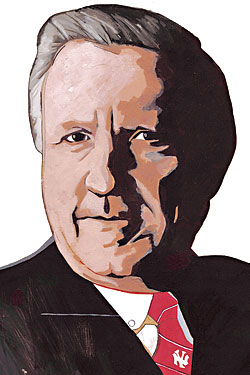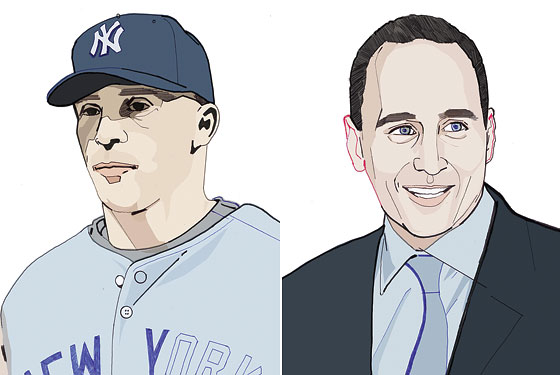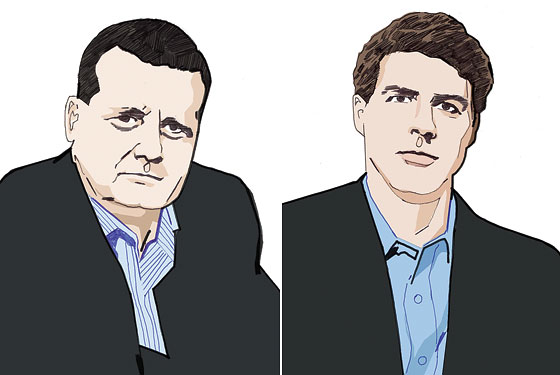
For the Yankees, it might have been a celebration, or it might have been a wake.
Sinatra was singing “New York, New York.” Elaine was smiling. It was yet another vintage night at her Upper East Side saloon, the kind that mixes moneymen, writers, stars, and neighborhood characters. This party had an unusually jockish vibe: It was the night before Major League Baseball’s All-Star Game, the last to be held at Yankee Stadium—the one and only original Yankee Stadium, anyway, where the Babe swatted and Jeter became a star. The one where George Steinbrenner became a maniacal legend.
George had been a regular at Elaine’s, too. He’d come in after big games needing to calm down, chatting with Elaine before heading to his suite at the Regency Hotel. But George hadn’t been in for a drink in years. A mysterious illness had turned him puffy-faced and sapped his strength. The next night, before the start of the All-Star Game, Steinbrenner would make a rare appearance at the stadium, riding in a golf cart to home plate, black sunglasses hiding his eyes but unable to hide his tears as the sold-out crowd roared for him.
The party was a quieter tribute—it was held at Elaine’s not simply because the place is a legendary New York joint but because it was George’s joint. There were plenty of folks from other teams, but it was a thoroughly Yankees affair, right down to the goody bags filled with pin-striped cookies. Joe Girardi, the Yankees’ current manager, brought his wife; Lou Piniella, one of Steinbrenner’s many former managers, mingled and laughed, too, and swapped stories with Madison Avenue admen and tabloid baseball writers.
But as much as it was a salute to the patriarch, it was also something of a coming-out party for the next generation. For years, George emptily proclaimed it was time to “let the young elephants into the tent.” Age and poor health had finally compelled him to do it. So Hal Steinbrenner, 39, recently installed as the team’s executive vice-president, made the rounds with a new stature. Jenny Steinbrenner, 48, spent much of the night at a table in the back, alongside Elaine; Jenny was married to George Steinbrenner’s heir apparent, Steve Swindal, until the couple divorced last year. Jessica Steinbrenner, in her mid-forties, was there, too; her second husband, Felix Lopez, supervises the Yankees’ facilities in Tampa.
Hal seemed ill at ease. “He didn’t really know these people,” said one partygoer and baseball lifer. “Hal hasn’t been around baseball.” Heads kept turning curiously every time the barroom door swung open. Surely, his brother, Hank, the best-known, most-quoted, most-George-like of the Steinbrenner kids, would come barreling in any minute. Hank was the son everyone expected to keep the dynasty going. He’d have to be here for the glossiest event of his brand-new tenure as senior vice-president of the Yankees.
Yet as the party petered out, not long after midnight, Hank Steinbrenner was a no-show. He skipped the All-Star Game, too. Where was Hank? “That’s not a question you’d ask with the crowd that was there,” says a family friend—meaning, most significantly, not around Hank’s kid brother.
On the field, the 2008 Yankees are desperately trying to stave off an unhappy ending. For the first time in thirteen years, the team is likely to fail to make baseball’s playoffs. But this season’s subtext has always been more interesting, and in many ways more dramatic, than whether Joba Chamberlain should be a starter or a relief pitcher. The most compelling plotline of this season has been about what happens to the Yankees, the New York institution, after George Steinbrenner dies. As the Boss drifts away, his family is like a tense party in search of a host.
In his prime he was an imperious bully. But George Steinbrenner was also a bully with a vision, and his impatience and his money revived a moribund franchise and propelled the team to six world championships. Steinbrenner did a lot of mean-spirited and dumb things, but his sense of urgency permeated the organization. And not coincidentally, Steinbrenner took the Yankees from a threadbare castoff valued at $10 million to a thriving behemoth worth more than a billion dollars. The TV network he created, called YES, has become a bonanza, and next year, another Steinbrenner dream will come true—a state-of-the-art, cash-minting, $1.3 billion new stadium.
The official line is that George Steinbrenner remains deeply involved in decision-making. But he had become a less forceful presence even before he got sick. And now that he’s almost completely offstage, his children have been forced into running the show. The two sons, Hank and Hal, are divided by their twelve years and their very different personalities. More threatening to the long-term success of the team, however, is the heirs’ ambivalence about actually taking charge of the franchise. So a question that for 30 years had a laughably simple answer—who’s running the Yankees?— is instead more complicated than it was seven months ago, at the start of the season. What’s clear is that life after George is going to be very different for the Yankees—and, in some ways, far more difficult.

Illustrations by Lyndon Hayes
One of George Steinbrenner’s gifts was a flair for bombastic, belligerent showmanship. The trait seemed to have made a latent appearance in Hank: For most of his 51 years, Hank had strenuously avoided any real role with the Yankees. But now that it had been thrust upon him—complete with a media-friendly, tear-jerking anecdote about Piniella’s telling Hank his father needs him now—Hank started the season playing the son-of-the-Boss part to the hilt. He was everywhere during spring training in Tampa, scowling, chain-smoking, firing off headline-ready quotes.
He’d gotten a head start during the fall of 2007, all but wishing Joe Torre, the four-time World Series–winning manager, good riddance. Then Hank dared Alex Rodriguez to leave town, and A-Rod backed down, signing a contract worth $275 million. As the regular season began, Hank seemed to revel in his almost-daily presence in the sports pages. He’d sound off on everything from the urgency of moving Joba Chamberlain from the bull pen to the starting rotation to the backwardness of the National League for refusing to add the designated hitter.
But it soon became apparent that sounding off was pretty much all Hank did. His high profile in the spring turned out to be a matter of geography: Training camp is in Tampa, in his backyard. “I watch the [regular season] games at home on TV, or I’ll watch ’em here at the office, or the first part of ’em, and then watch the second part at home, wherever I happen to be, my girlfriend’s house, whatever,” he told me affably one afternoon in the middle of the season. Some things still got him huffing and puffing, like the delay in making Chamberlain a starting pitcher. “See, the Red Sox did it right, with Buchholz and Lester. They brought them along as starters and nothing else. So Buchholz throws a no-hitter last year, Lester throws one this year. Well, Chamberlain could have thrown one already, I think, had he been brought along that way. And that’s the way he should have been brought along.”
Yet for all Hank’s regular-guy charm, his tendency to splutter like a sports-radio caller has often come across as graceless, never more so than when he was leaving an 11–3 rout by the Red Sox in late August, just the second Yankees home game he had attended all year. “They sucked,” he said while storming across the parking lot.
Because Hank, unlike his father, hasn’t backed up the blather by firing or blaming anyone inside the organization, he quickly went from endearing to irrelevant. One indelible indicator of how he’s viewed within the organization came from Suzyn Waldman, the fiercely loyal Yankees radio broadcaster. In May, during an interview on WFAN, Waldman casually said, “I don’t think anybody pays attention” to Hank’s pronouncements. Accurate as her analysis is, the fact that Waldman was willing to say it publicly, without worry of discipline by Yankees management, was a telling indication of the political dynamic: No one is scared of Hank.
Hal is the stealth Steinbrenner. Back in 2002, when he was in charge of the family’s hotel properties, Hal stepped in to undo one of his father’s worst ideas—slashing the dental benefits of low-ranking Yankees staffers. George needed to punish someone after the team, big winners in the regular season, flamed out in the first round of the playoffs. He didn’t seem to care about the public-relations nightmare. Until Hal talked his father down, even offering to pay the dental premiums out of his own pocket. Yet Hal made his case so quietly that his actions weren’t publicly known until the following year.
Hal’s arrival as Yankees executive vice-president during the winter was overshadowed by his older brother’s bluster, but he was diligently learning the organization and asserting himself in ways that Hank didn’t. Hank is heavyset, perpetually rumpled, and favors shapeless blue blazers; Hal looks as if he parts his hair with a razor blade, and he is buff enough to sport Under Armour short-sleeve shirts.
As the season began, Hal’s primary focus was working with Randy Levine, the team president, to oversee completion of the new stadium. Levine was one of Rudy Giuliani’s most powerful deputy mayors. In 2000, Levine left City Hall for the Yankees, becoming George Steinbrenner’s chief aide in expanding the team’s business reach. Hal’s other guide, and currently the key person in the baseball power structure, is Brian Cashman, the Yankees’ general manager since 1998. Like Levine, Cashman is a savvy political player. Three years ago, he was on the verge of walking away from the Yankees unless handed complete control of baseball operations; Steinbrenner, in what may turn out to have been his last important act as owner, agreed.

Illustrations by Lyndon Hayes
Cashman was prepared for 2008 to be a rocky transition year, and the team actually stayed in the race longer than many expected. Unfortunately, the youth movement Cashman championed has been a dud so far. Ownership may push him to reload fast: The Yankees could shed $85 million in payroll this winter, as contracts with past-their-prime players like Jason Giambi come to an end.
The first real and messy test of who wears the executive pants in the family won’t come over free-agent sluggers, however; it is already well under way, with a deadline of October 31, when Cashman’s contract expires. During the summer, Hank and Hal issued contradictory statements about their interest in retaining the general manager, with Hank saying he was in favor and Hal wanting to wait and see. Last week they met with Cashman in Tampa, generating a story in the Post that both brothers now favor bringing Cashman back. Even if that’s true, it seems they’re continuing one George Steinbrenner tradition: allowing executives to dangle in the breeze before making a deal.
Hal Steinbrenner appears to have bought into Cashman’s long-term rebuilding program, but his own ambitions aren’t so transparent. For a decade, he was content to live in Florida and oversee the family’s hotel properties, staying out of the way of his domineering dad. As this season began, he seemed most interested in watching over the family’s investment, and in joking to reporters that he wanted them to use a good picture of him to help him get dates. Now, though, Hal has had his first real taste of the joys and pain of a pennant race, and the ego thrill of manipulating a ball club. Though he also lives in Tampa, not far from the three children he shares with his ex-wife, it’s Hal who flies frequently to New York to talk about players with Girardi and Cashman. Hal has slowly become more visible, allowing himself to be caught by reporters for short interviews while exiting Girardi’s office. “Hank doesn’t want to be there, but Hal does,” says a person who’s done business with the family. “And he’s not gonna want to share that limelight.”
Hank, however, remains the wild card. Will he back off and return to the Florida horse business that’s his real love? Or will losing this year—and especially the brutal mocking he’s taken from the New York newspapers—propel Hank to throw his weight around, letting his inner George loose and demanding that the Yankees wave huge contract offers at free agents like C. C. Sabathia and Mark Teixeira? After all, wasn’t Hank right, last winter, that the Yankees should have traded Melky Cabrera and a couple of those kid pitchers Cashman loves for Johan Santana? “There’s going to be a lot going on this off-season,” Hank promised after that ugly loss to Boston last month.
Of course, another possibility is more hot air. “Randy and Brian have put together a very functional leadership group,” says one prominent baseball agent. “Hank and Hal are more of an aggravation than anything. I don’t think Brian would be there after all these years if he couldn’t really run the club.” If the brothers decide to bring back Cashman, they will essentially be relegating themselves to figureheads.
In July, when Goose Gossage was inducted into the Baseball Hall of Fame, the great old shaggy Yankees relief pitcher couldn’t stop telling George Steinbrenner stories. One of his favorites was about how the Boss would storm in, purple with rage, and scream at the team after losses.
That was a long time ago. A tyrant owner, especially in New York, would probably be a disaster these days. “Baseball is not the same game George bought into in ’73,” says Bill Madden, the longtime Daily News baseball writer who is working on a biography of Steinbrenner. “I don’t see any way he could have possibly operated a team, a business of this magnitude, the way he used to, where nothing got done without his approval. The old George ways, that world doesn’t exist anymore, and not just because George has faded.”
Yet the Yankees remain a family business—a splintered-family business. The fear is gone from the front office, but the tension between Hal and Hank, and their conflicting management styles, may not end up providing anything near the leadership that George did.
Bloodless corporate ownership would be even worse, but that may be where the Yankees are inevitably headed. The gilded new stadium, with its martini bars and seats priced as high as $2,500 per game, is coming online in the middle of an economic downturn. Last year, Goldman Sachs quietly shopped the YES network, one pillar of the team’s financial success. Selling the cable channel, which could bring in as much as $3 billion, might be one strategy for the Steinbrenner family to pump cash into the team and maintain control. Or, more likely, it could have been a test of how much they could cash in by selling the team entirely when George is gone.
Mariano Rivera shrugs. He looks around the locker room he’s called home his entire career; he glances in the direction of the pitcher’s mound where he’s become the greatest closer in baseball history. Will he miss Yankee Stadium? “Not really,” he says. “I just want to be a part of opening the new stadium.”
Rivera is one of the few guaranteed a spot across the street on Opening Day 2009. Another, Derek Jeter, sits in a chair facing his locker. On Jeter’s left are stacks of brand-new Nike cleats. On his right is an empty locker, preserved this way since the 1979 plane-crash death of catcher Thurman Munson.
The Yankees are the most death-haunted team in sports. Partly that’s due to the franchise’s long history and unparalleled success—it simply has more all-time-great players to memorialize than any other team, so the black armband of mourning seems to have become a permanent part of the Yankees uniform. This year, the team is honoring former center fielder Bobby Murcer, lost to cancer in July.
The final Yankee Stadium game is scheduled for September 21. Yes, the old stadium is outmoded, cramped, and uglified by the seventies renovation. But it truly is one of a kind. Next year, the Yankees will have shiny luxury boxes for the corporate customers and cavernous locker rooms for the players, a massive high-def video screen above the outfield, and a panoply of non-hot-dog delicacies at the concession stands—just like every other modern ballpark. Maybe the Steinbrenner sons are in the embryonic stages of a genius new division of labor for a new era, with Hank supplying the juicy quotes and Hal doing the inside work of watching the money. But with the waning of George Steinbrenner, the incomparable Yankees are on their way to becoming just another team.